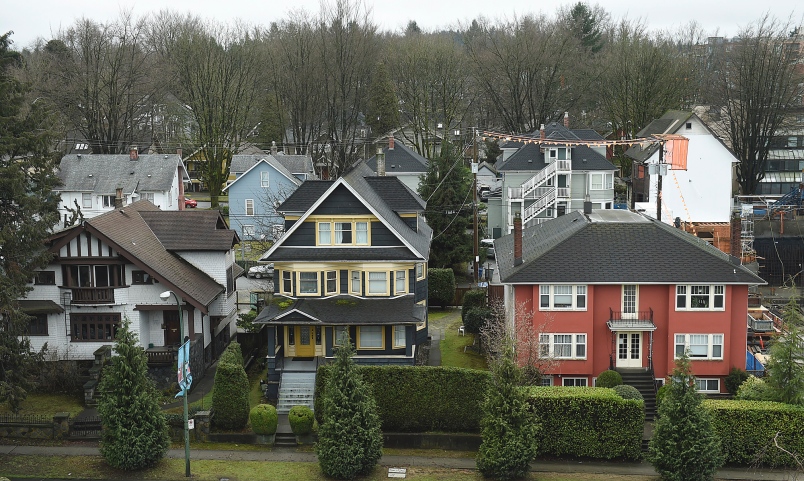Sole Downtown features small, affordable condos in city centre
? MICHAEL BERNARD
The Vancouver Sun
Project: Sole Downtown
Project location: 1350 St. Paul St., Kelowna
Project size/scope: 40 condos on top three floors of a six-storey concrete and wood-frame building, with three floors of commercial/retail space below. In Kelowna’s downtown district, an easy walk to restaurants, theatre, Waterfront Park and Rotary Centre for the Arts.
Residence size: Studio suites 389 sq. ft.; one- bed and one-bed-and-den 623/662 sq. ft., and two-bed 742/771 sq. ft.
Prices: $155,900 — $329,900
Developer: Sole Squared Developments
Architect: MQN Architects, Vernon
Sales centre: 1290 St. Paul St.
Sales contact: Maureen Cousins, Epic Real Estate Solutions, Kelowna
Hours: By appointment
Telephone: 1-866-679-3742 Website: soledowntown.ca
Occupancy: September 2017
After languishing for a few years following the 2008 financial meltdown, Kelowna’s downtown neighbourhood is taking on a new hip look that is attracting younger professionals interested in a different, more sustainable form of housing, says the creator of the new Sole Downtown development.
“Sustainable” also means that the 40 suites in the six-storey concrete and wood-frame building are distinctly smaller than what has been built before in Kelowna, with homes ranging from a 389-squarefoot studio suite to a 771-squarefoot two-bedroom home.
“There is no question that there has been an acceptance of Vancouver-sized apartments in Kelowna,” says Kevin Edgecombe, whose company, Edgecombe Builders Group, has been building in the Okanagan Valley since 1989. “I think we are the pioneer of that to some degree.”
But while it’s not uncommon to see these size homes fetching $500,000 and up in Vancouver’s Yaletown, prices are much lower in Kelowna, with the studio suite going for less than one third of that.
Not that there haven’t been a few bumps in the road for Sole Squared Developments, which Edgecombe formed with three other partners. “We tried to launch Sole (the first building) in 2010,’’ he said, adding, “when we came up with a 389-square-foot studio suite, people shook their heads and said ‘Really, Are you kidding me?’”
After some tinkering with the design — it included converting the first three storeys into commercial office space — the concept gained traction, he said. Sole Downtown, which is almost a duplicate of the first Sole building, has been far easier to market, with about 70 per cent of homes sold to date. Part of the reason is that the Interior Health Authority building and the Innovation Centre under construction are expected to inject more than 1,200 permanent jobs into the downtown core, making urban-style housing attractive for workers.
The project’s name derives from a group discussion about branding that focused on concepts such as the size of the project footprint and the efficiency of the building, spawning the catchphrase “small footprint, big life,” Edgecombe says.
Ironically, his company, Edgecombe Builders Group, cut its teeth constructing luxury homes of 5,000 to 8,000 square feet in more luxurious settings, such as the Okanagan lakefront. But Edgecombe says he started looking at different approaches to housing after reading Garth Turner’s prophetic book 2015: After the Boom, in which the financial guru predicts a future glut of larger homes as baby boomers age.
“To me, the size of some of these houses is ridiculous, with just two or three people living in them,” Edgecombe says. “They are going to become our albatrosses.”
The look and design of the first building would easily fit into downtown Vancouver. The structure, an unusual combination of concrete on the lower floors and wood frame on the upper storeys, makes liberal use of modern materials, including vertical corrugated steel panels, aluminum-framed glazing and glass-plate balcony railings. A glass-sided elevator car gives the visitor a view of the neighbourhood as the car rises up an exterior glass column.
Inside the Sole Downtown homes, the sense of space will be enhanced by nine-foot-high ceilings, and 10-to-12-foot vaulted ceilings on the sixth floor. Walls can be painted in grey, “edgy blue” or “edgy green” while flooring is done in the highly durable vinyl plank.
The compact kitchens are equipped with quartz countertops and stainless steel backsplash. Cabinetry is Euro-style, reaching to the ceiling bulkhead for maximum storage capacity. Another notable feature is a custom-designed island with a built-in dining table in the form of a partial circle. Appliances are smaller but efficient with a 24-inch Frigidaire ceramic top electric stove, a compact Energy Star-rated dishwasher and a 12-cubic-foot Electrolux fridge with freezer drawer.
The bedrooms have large windows for maximum natural lighting and are set off from the living areas by sliding opaque glass doors. An innovative and practical feature is an elevated valance shelf at top of door height for handy and ample storage.
In the bathrooms, buyers can choose between a tile-surround walk-in shower with frameless glass doors or an optional bathtub. Cabinetry is the floating Eurostyle variety topped with quartz counters.
The common amenity spaces on the sixth floor include a fitness room and 1,000-square-foot balcony area, which faces south with a barbecue, fire pit couches and a dining table.
“We removed two units from the top floor and inserted the amenities,” Edgecombe says. “We picked a prime location, arguably too prime because we probably left money on the table there. However, we believe it adds to the cachet of the whole project. It is quite impactful.”
© Copyright (c) The Vancouver Sun


